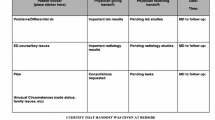Abstract
Admission handoff is a high-risk component of patient care. Previous studies have shown that a standardized physician electronic signout (“eSignout”) may improve ED-to-inpatient handoff safety and efficiency in teaching hospitals. This model has not yet been studied in non-teaching hospitals. The objectives of the study were to determine the efficiency of an eSignout platform at a community affiliate hospital by comparing ED length of stay (LOS) for a 5-month period before and after implementation and to compare the quality assurance (QA) events among admitted patients for the same time period. A retrospective, interventional study was conducted with the main outcome measures including ED LOS with calculation of 95% CI, mean comparison (t test), and number of QA events before and after implementation of the eSignout model. Prior to eSignout implementation, 1045 patients were admitted [mean ED LOS 330.0 min (95% CI 318.6–341.4)]. Following implementation, 1106 patients were admitted [mean ED LOS 338.9 min (95% CI 327.4–350.4, p = 0.2853)]. Nine pre-implementation QA events and six post-implementation events were identified. Use of a physician eSignout in a non-teaching hospital had no statistically significant effect on ED LOS for the admitted patients. The effect of an electronic interdepartmental handoff tool for patient safety and clinical operations in the non-teaching setting is unclear.


Similar content being viewed by others
References
Ong MS, Coiera E (2011) A systematic review of failures in handoff communication during intrahospital transfers. Jt Comm J Qual Patient Saf 37(6):274–284
Arora V, Johnson J, Lovinger D et al (2005) Communication failures in patient signout and suggestions for improvement: a critical incident analysis. Qual Saf Health Care 14:401–407
Horwitz LI, Krumholz HM, Green ML et al (2006) Transfers of patient care between house staff on internal medicine wards: a national survey. Arch Intern Med 166:1173–1177
Beach C, Croskerry P, Shapiro M (2003) Profiles in patient safety: emergency care transitions. Acad Emerg Med 10:364–367
Sinha M, Shriki J, Salness R et al (2007) Need for standardized signout in the emergency department: a survey of emergency medicine residency and pediatric emergency medicine fellowship program directors. Acad Emerg Med 14:192–196
Hilligoss B, Cohen MD (2013) The unappreciated challenges of between-unit handoffs: negotiating and coordinating across boundaries. Ann Emerg Med 61(2):155–160
Davis J, Riesenberg LA, Mardis M, Donnelly J, Benningfield B, Youngstrom M, Vetter I (2015) Evaluating outcomes of electronic tools supporting physician shift-to-shift handoffs: a systematic review. J Grad Med Educ 7(2):174–180
Horwitz LI, Meredith T, Schuur JD, Shah NR, Kulkarni RG, Jenq GY (2009) Dropping the baton: a qualitative analysis of failures during the transition from emergency department to inpatient care. Ann Emerg Med 53(6):701–710
Apker J, Mallak LA, Gibson SC (2007) Communicating in the “gray zone”: perceptions about emergency physician hospitalist handoffs and patient safety. Acad Emerg Med 14:884–894
Abraham J, Kannampallil T, Patel VL (2014) A systematic review of the literature on the evaluation of handoff tools: implications for research and practice. J Am Med Inform Assoc 21(1):154–162
Russ S, Rout S, Sevdalis N, Moorthy K, Darzi A, Vincent C (2013) Do safety checklists improve teamwork and communication in the operating room? A systematic review. Ann Surg 258:856–871
Snow V, Beck D, Budnitz T, Miller DC, Potter J, Wears RL, Weiss KB, Williams MV (2009) Transitions of Care consensus policy statement: American College of Physicians, Society of General Internal Medicine, Society of Hospital Medicine, American Geriatrics Society, American College of Emergency Physicians, and Society for Academic Emergency Medicine. J Hosp Med 6:364–370
Saufl NM (2009) 2009 National patient safety goals. J Perianesth Nurs 24(2):114–118
Kessler C, Scott NL, Siedsma M, Jordan J, Beach C, Coletti CM (2014) Interunit handoffs of patients and transfers of information: a survey of current practices. Ann Emerg Med 64(4):343–349
Gonzalo JD, Yang JJ, Stuckey HL, Fischer CM, Sanchez LD, Herzig SJ (2014) Patient care transitions from the emergency department to the medicine ward: evaluation of a standardized electronic signout tool. Int J Qual Health Care 26(4):337–347
Centers for Medicare and Medicaid services: glossary and acronyms; (updated 2016 July 27). https://www.cms.gov/OpenPayments/About/Glossary-and-Acronyms.html#teachinghospital. Accessed 5 Feb 2018
Singer AJ, Thode HC Jr, Viccellio P, Pines JM (2011) The association between length of emergency department boarding and mortality. Acad Emerg Med 18(12):1324–1329
Smith CJ, Britigan DH, Lyden E, Anderson N, Weniak TJ, Wadman MC (2015) Interunit handoffs from the emergency department to inpatient care: a cross-sectional survey of physicians at a university medical center. J Hosp Med 10(11):711–717
Dubosh NM, Carney D, Fisher J, Tibbles CD (2014) Implementation of an emergency department sign-out checklist improves transfer of information at shift change. J Emerg Med 47(5):580–585
Author information
Authors and Affiliations
Corresponding author
Ethics declarations
Conflict of interest
The authors declare that they have no conflict of interest.
Statement of human and animal rights
All procedures performed in this study were in accordance with the ethical standards of the independent Beth Israel-Needham oversight and quality assurance committee and with the 1964 Helsinki declaration and its later amendments or comparable ethical standards.
Informed consent
For this type of study (retrospective), formal consent is not required.
Rights and permissions
About this article
Cite this article
Singleton, J.M., Sanchez, L.D., Masser, B.A. et al. Efficiency of electronic signout for ED-to-inpatient admission at a non-teaching hospital. Intern Emerg Med 13, 1105–1110 (2018). https://doi.org/10.1007/s11739-018-1816-z
Received:
Accepted:
Published:
Issue Date:
DOI: https://doi.org/10.1007/s11739-018-1816-z




